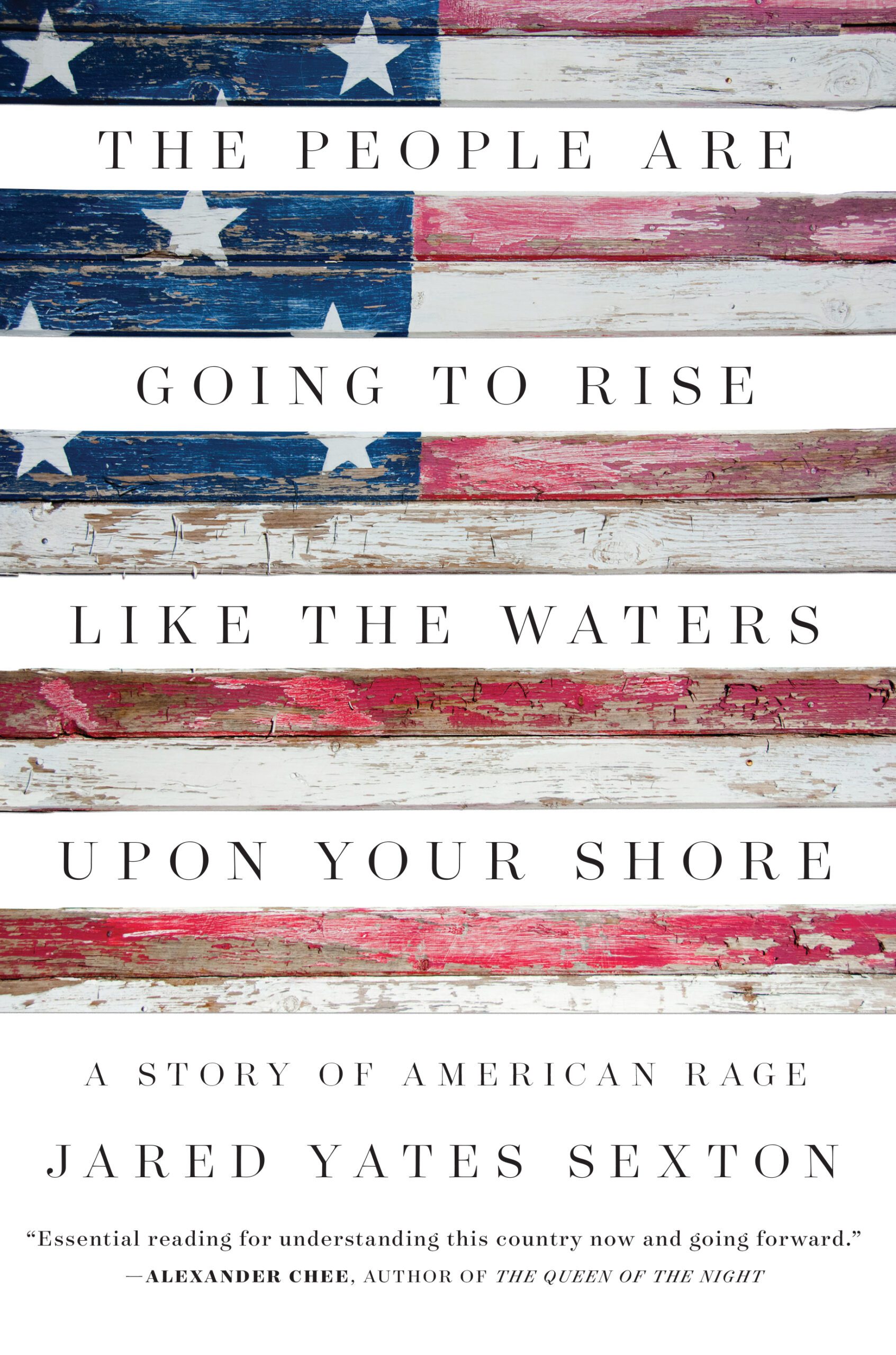
Jared Yates Sexton’s book, like so many of our country’s problems, began with a tweet. In April of 2015, Sexton, a professor of creative writing at Georgia Southern University and a novelist, began working as an election correspondent for the literary magazine the Atticus Review. In June of that year, he attended, and live-tweeted, a Trump election rally. His 140-character observations quickly went viral. His tweets inspired the ire of the alt-right, death threats, two articles for the New York Times, an agent, and a book deal.
The resulting book, The People Are Going to Rise Like the Waters Upon Your Shore: A Story of American Rage (out from Counterpoint Press tomorrow), posits itself as an exploration of the anger of the white, Red State American. This anger, Sexton argues is responsible for the rise and eventual election of Donald Trump.
He writes of Trump’s early bid:
While comedians and pundits dismissed him—The Huffington Post went so far as to cover his efforts in their Entertainment section rather than Politics—the dismissiveness and irony always tended to ignore two key factors that would fuel his ascent: the unvarnished anger of his message and the bold-faced bigotry he peddled.
Beginning with the Iowa Straw Poll, dipping into the mass murder at the Emmanuel AME church, and swinging back out again, Sexton’s book is a whiplash trip through an all-too-recent election. There are quieter moments, too, of watching cable news in dingy hotels, and of drinking cheap watered-down beer with locals. But every moment is scorched through with white male rage.
The book is meant to be a Kurtz-like journey into the dark heart of white Middle America but gets lost in the weeds of its own observations and instead becomes an idiosyncratic portrait of a country, revealing nothing except what our narratives have always overlooked—the concerns of women and people of color.
Sexton reminds us often throughout the book that he is just a normal guy, from a blue-collar working-class family in Indiana. He identifies with the working-class bartender sick of the Green Party convention attendees. He shoots the shit with day laborers in front of a sketchy hotel. Sexton is a man of the people. And yet, his identifications don’t offer any insight when it comes to Trump’s supporters. While he claims to identify with their plight—poor, working-class, drinkers of bad beer—his language is the language of contempt. He expresses “disgust” with their rhetoric. He calls Antonio Sabato, Jr., an “idiot soap opera actor” and Rudy Giuliani a “race-baiting, rat bastard.” Roger Stone is an “infamous Nixon ratfucker.”
“Trump’s true talent was finding the pulse of these ignorant, livid people and playing them like a virtuoso strumming instrument,” writes Sexton.
With this language, Sexton shreds objectivity in a valiant Gonzo-like effort. But in a book that argues we are divided and stuck in our own echo chambers, Sexton’s own divide goes unexamined, his own echo chamber unchallenged.
Sexton goes to lengths to deny his lack of objectivity, noting that despite receiving death threats, he can ride in a car with a Trump supporter—a situation that is more exemplary of white male privilege than some sort of hope for political unity. His contempt for Trump supporters ultimately undermines his analysis. A writer cannot offer humanity and complexity on the page while simultaneously insulting and despising his subjects. How can Sexton identify with the people he is profiling and also dismiss them with classist language? It’s a contradiction that would have been worthy of examination; instead, it’s glossed over.
And his careless words also feed into dangerous stereotypes about Trump supporters that whitewash the complexity of our nation’s divide. Sexton goes to great lengths to identify Trump supporters as working class, a claim he never proves with statistics, only with anecdotes. But the claim doesn’t hold up to scrutiny. Sarah Smarsh, writing for the Guardian in October of 2016, noted (in one of the few good takes on the election) that Trump supporters are hardly the oppressed classes of workers.
Earlier this year, primary exit polls revealed that Trump voters were, in fact, more affluent than most Americans, with a median household income of $72,000—higher than that of Hillary Clinton or Bernie Sanders supporters. Forty-four percent of them had college degrees, well above the national average of 33% among whites or 29% overall. In January, political scientist Matthew MacWilliams reported findings that a penchant for authoritarianism—not income, education, gender, age, or race—predicted Trump support.
These facts haven’t stopped pundits and journalists from pushing story after story about the white working class’s giddy embrace of a bloviating demagogue.
This giddy embrace of Trump is just what Sexton himself giddily embraces, taking pains to note with his novelist’s eye the caricatures of American rage, so much so that the profiles of everyone, excepting Bernie Sanders and Sexton himself, read more like parodies than profiles of actual humans.
Writing for Jezebel, in one of the only other good takes of 2016, Stassa Edwards calls out this genre of white men elucidating the harsh realities of Trump rallies. She notes the inherent contradiction that plagues profiles of Trump supporters, including Sexton’s work:
Ultimately, it seems that the Trump rally reportage piece has no purpose other than to reaffirm the importance of a certain kind of writer and his observations. It tells us little about the motivation of Trump voters and reduces violence to vignettes in an obviously grotesque sea of inhumanity. Its sole purpose seems to be the belatedly obvious conclusions of the reporter. It is, in short, an affirmation to both the writer and a particular kind of reader that they are good and moral and correct. That they both, by the very nature of taste and comportment and liberal consciousness, have nothing in common with the otherworldly inhabitants of a Trump rally.
And this happens in The People Are Going to Rise because no one else, aside from Sexton, is allowed complexity or sympathy on the page. One of these moments of sympathy for Sexton comes when he details the death threats he begins receiving in the wake of his viral tweets, the mysterious cars that idle by his house late at night, and the campaign to get him fired from his tenure-track job. He is shocked at the outrage that has spilled over into threats of violence. America, he concludes must be in bad shape. No one can fault him for his fear. Death threats and online harassment are bad, and are things I understand well as a woman who has an opinion online.
Sexton’s harassment is used as an example of rage from the teeming white mass of “others,” but it entirely overlooks the rampant history of online harassment and threats that have long plagued women in media. For Sexton, his vulnerability is evidence of a problem with all of America, while for women, harassment is just part of doing business.
In a June 2016 article for The New Republic, Sexton does acknowledge gender differences in online harassment. But in that same article, Sexton also prides himself for being able to meet his harassers halfway, noting magnanimously that they often drop their arguments once he engages with them. In the book, there is a parallel conciliatory narrative, when he gets in the car with Dave, a young Trump supporter, and together they drive to a Clinton rally. Reading that section, the only conclusion that I could come to was the only conclusion not examined on the page: all things are possible when you are white, male, and don’t have to worry much about being murdered, raped, or having your kids’ safety threatened. What Sexton is proud of here, he touts as a way to overcome the divide, but it’s really just white, male privilege.
The contrast between who is and isn’t allowed to feel rage in Sexton’s book is stark. In the wake of the massacre at the Emanuel AME in Charleston, Sexton shows not the righteous and justified rage of black writers like Roxane Gay. Instead, he shows conciliatory forgiveness, hymns, prayers, tears, and sadness. When it comes to women, Sexton writes off Hillary Clinton supporters as casting their lot with her only because Elizabeth Warren hadn’t run. Even when discussing Trump’s sexist language like “pussy grabbing” and “nasty women,” women are still not allowed to have rage. It’s never present on the page, which, in a book about American rage, is an egregious oversight. The overwhelming anger of women and people of color have fueled massive protests since the election, and Sexton doesn’t dwell on this at all.
In a poignant moment, Sexton, on his journey with Dave, calls out a fake story about Clinton’s supposed anger, insisting to Dave that it can’t be true. Of all the fake stories that came out of the election, one about Clinton’s rage likely has the most veracity. But here again is an erasure of a woman’s anger. Instead, Sexton portrays Clinton only as a scheming politician, desperate to win, calling her rallies “slick to a fault” and comparing her campaign to the next rollout of an Apple product. And, of course, mentioning that she colors her hair. She’s more machine than human. It’s more flippant, Gonzo-like language that, again, undermines the thesis of the book and values white male rage over all the competing strains of anger in America.
And what of the fifty-three percent of white women who voted for Trump? Where is their rage? Aren’t they, too, allowed to be more than just part of the screaming horde? Where do they fit in with the out-of-work, beer-swilling, male masses? I don’t have the answer, because those woman aren’t present in the book either.
Make no mistake though, Bernie Sanders is allowed his rage. Sanders’s rage is portrayed as authentic and pure, somehow. It’s a rage for the people and of the people—a rage that is offset by Sexton’s highlighting of the moment when a bird landed on Sanders’s podium in March of 2016, which quickly became an Internet meme.
Begun with a series of tweets, The People Are Going to Rise fails to rise above surface-level observations, privileging white male rage over all other strains of anger that surge through America, including the anger we now see growing against the current administration. An anger that is a Jesus-like, table-flipping rage, which inspires disabled activists to be handcuffed at the capitol and grandmothers to don hats that look like vulvas. To ignore this anger is the willful ignorance of white male privilege.
***
Author photograph © Danielle Debien.





